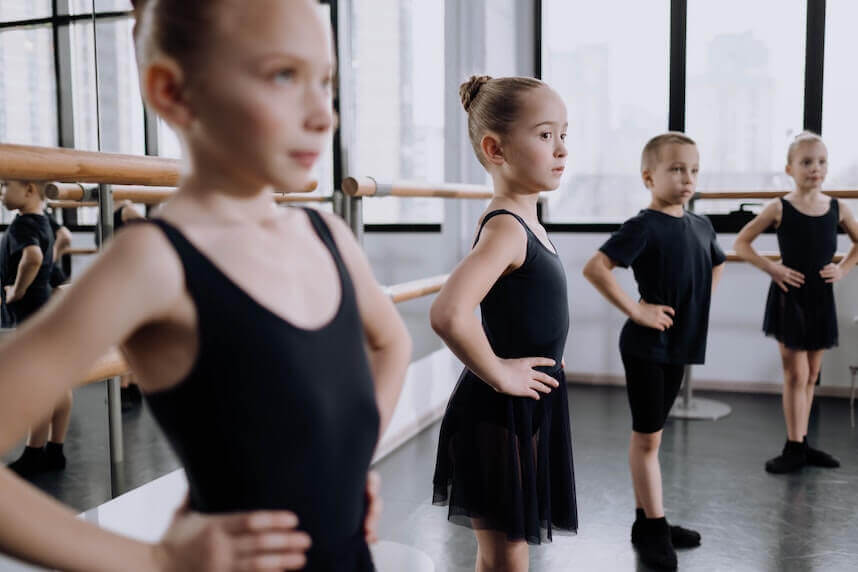Are you ready? There are 9 ballet movements that tone the muscles of the whole body. Let’s go.

PLIÉ
Plié in the first position is one of the basic elements of ballet. Stand in the first position and start bending your knees slowly until your knees are over your thumbs. Hold on to this position for a second and then return smoothly and quickly upwards. Complete the movement in the first position.
Plié should be performed in all 5 main ballet positions. There are two types of pliés: demi and grand.
GRAND PLIÉ
The Grand Plié also performs from the first position, but unlike the Plié, you sit much lower, tearing your heels off the floor.
RELEVE
Releve is a basic movement that almost all newcomers learn. To perform a simple releve, take the first position and hold the ballet barre with one hand. Tension the caviar muscles and pull up to be on your socks. Transfer all the weight to the part of the foot that is under your fingers. This position is called the demi-pointe. Then gently fall down.
Try to do single-leg releve as well. This exercise is good for strengthening the back surface of the hip and calf.
Over time, you try to connect the plié and the releve. First, make a plié and then climb up in the releve using the strength of your feet on climbing.
BATTEMENT TENDU
Battement tendu is an exercise in which the working leg is either pulled aside and then returned, or bent and unbent. There are several different types of battement with which you can practice the ability to correctly move your leg back to the original position, bend and stretch the leg, pull it out and lift it to any height in any direction and at any speed.
JETE
In this exercise, the working leg moves in three directions: forward, to the side, back and again to the side. But the sock is detached from the floor every time. The leg is raised to the position in which it will make from the other about 45 degrees. After making the whole chain of movements, repeat the jete from the other leg.
ROND
Push your right foot forward without tearing your sock off the floor. Smoothly, drawing a semicircle, move it to the side and then back. Return to the original position, repeat 6 times with each foot.
FONDU
Lower into the demi-plie by bending the supporting left leg and leading the sock to the right of the ankle stone. Unbend the supporting leg and pull the right one forward. Return to its original position. Repeat the movement by pulling the right foot to the side, but then lower into the demi plié, leading the right foot behind the shin with the left foot. Straighten the supporting leg by pulling the right foot back. Move the side again and return to the original position. Perform the exercise 4 times from each leg.
SAUTE
Saute is a jump with no position change. It is convenient for learning the mechanics of jumping with novice students. Its study is started separately, with pauses before each jump. Saute consists of three main points: half-sitting (preparation for the jump), the jump itself and landing (half-sitting). The jump is made by jumping with the pushing of heels from the floor.
During the jump, the legs in the air are stretched in the knees to the limit, toes are stretched too, and the body is straight, no tension, the legs in the air retain the given position. When landing after the jump, the socks touch the floor first, then the whole foot is lowered and a half-squat is made evenly on both feet. Keep the body straight.
ADAGIO
Get in the fifth position. Push your right foot forward as in a battement tendu, but then raise it, straight, to the parallel with the floor. Go back to the fifth position and also through the battement tendu lift the foot to the parallel with the floor to the side. Then make the same move back, again to the side and return to the original position. Repeat with the other leg.
So, after these ballet moves for beginners, are you ready to wake up the ballerina inside of you?
Related articles:

The “Arabian” Dance in The Nutcracker

Ballerina Feet: Ballet & Foot Health

The 9 Greatest Choreographers of the 20th century
- About the Author
- Latest Posts
Professional Dancer, Dance coach. Favorite dance style – Pole Dance. Favorite Move – Sword Simakhina. A graduate of Saint Marys. Former Chief Editor and Owner of DanceBibles.com


